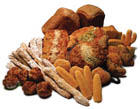
“Okara is unique from a nutritional standpoint because it provides a good source of both dietary fiber and protein,” says Cathy Peterson, director, applications and ingredient innovation at SunOpta Ingredients Group. Containing 58% dietary fiber and 28% protein, okara is relatively easy to add to a product to help achieve a nutrient content claim for fiber. Okara addition also can help boost protein levels in food, as it has moisture- and oil-binding properties that make it an ideal low-cost ingredient to help increase yield in meat products.
The bland flavor of okara allows it to be used at relatively high usage levels without negatively affecting flavor or texture profiles of meat and bakery products. Yield improvements in meat systems of 5% to 8% in cooked pork sausage and 10% in cooked ground beef have been measured. The moisture retention and improved cook yields allow for enhanced nutritional profiles with lower fat and calorie content, as well as increased fiber and protein levels. Okara also has been shown to have a positive effect on shelflife in chocolate chip cookies at an optimum level of 5%, and prevent syneresis in cheese ravioli filling during freezing and thawing. In gluten-free or wheat allergen-free products, okara also can be a valuable ingredient.
The properties mentioned above allow okara to be used in place of other sources of dietary fiber. It can replace modified food starch, breadcrumbs and other binders in meat fillings, patties and analog pieces.
Canadian Harvest Organic Oat Fiber 100, another suitable ingredient for use in natural, organic and healthy foods and beverages, is 85% total dietary fiber. Its low water-absorption properties make it a good choice for fiber enrichment. Nutrient content claims, such as a “good source” or “excellent source” of fiber, easily are achieved with the addition of approximately 4% to 6% oat fiber, depending on the application and serving size.
Formulations are available for fiber-enriched muffins, bread, brownies, cookies and nutrition bars. Chicken patties also have been developed with added oat fiber to increase yield and reduce cost.
For more information:
SunOpta Ingredients Group, Bedford, Mass.
Cathy Peterson • 781-276-5124 cathy.peterson@sunopta.com